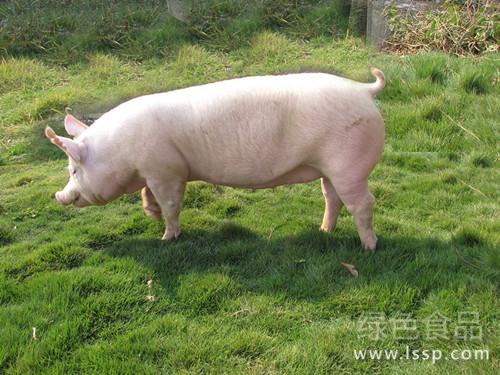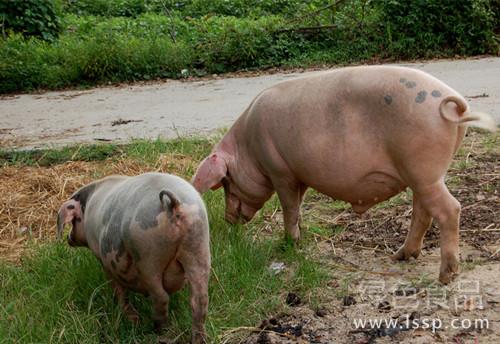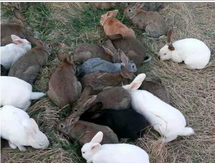Nutritional requirements and feeding of healthy pregnant sows with adequate nutrition
The pregnancy of sows begins from mating to the end of delivery. The goal of feeding and management is to ensure the normal development of the fetus in the mother, to prevent abortion and stillbirth, to produce strong, vital and important newborn pigs, and to keep the sows in high and middle condition. Pregnant sows should control the appropriate nutrition level. According to the feeding standard of our country, when the weight of the sow in the first 80 days of pregnancy is 90 kg ~ 120 kg, the daily feed intake is 1.7 kg, the body weight is 120 kg ~ 150 kg, the daily feed intake is 1.9 kg, and the daily feed intake is 2 kg over 150 kg body weight. The body weight in the third trimester (prenatal month) was 90 kg ~ 120 kg, 120 kg ~ 150 kg and more than 150 kg, and the daily feed intake was 2.2 kg, 2.4 kg and 2.5 kg, respectively. The dietary nutrition level is 12%-13% for crude protein, 2.8-3.0 MCAL / kg for digestible energy, 0.4%-0.5% for lysine, 0.6% for calcium and 0.5% for phosphorus. In addition, in addition to feeding formula feed, in order to make sows feel full and supplement vitamins, it is best to match with excellent varieties of green feed or roughage.

Sow
The corresponding feeding system and nutrition plan should be adopted according to the different characteristics of pregnant sows. For the lean sows after weaning, we should take care of the feeding system and nutrition plan in the middle. The sows after childbirth and lactation have higher physical exertion and poor physique. In order to better undertake the task of reproduction in the next stage, it is necessary to strengthen nutrition in the early stage of pregnancy and quickly restore the reproductive condition. During this period (including the first 10 days of mating, a total of about 1 month), nutrition should be strengthened and the supply of concentrate should be increased, especially those with high protein content. After the recovery of physical condition, the nutrition level was gradually reduced and raised according to the feeding standard, mainly green roughage, to 80 days of pregnancy, concentrate was added to strengthen nutrition. To form a high-medium-high feeding system and nutrition plan, especially the nutrition level in the later stage should be higher than that in the early stage.
A step-by-step feeding plan should be adopted for parturient sows and lactating sows. Especially for parturient sows, the body is still in the stage of growth and development, and the nutritional requirements are large, so it is more necessary to adopt this plan. Because of the heavy reproductive task and large nutritional requirements of lactating sows, the nutritional level of lactating sows should be increased according to the growth of fetal weight, reaching the peak one month before delivery. In general, the nutrition level in the early stage of pregnancy can be lower, mainly green roughage; then gradually increase the proportion of concentrate, especially the supply of protein and mineral materials, and improve the nutrition level; to 3-5 days before delivery, the diet is reduced by 10% to 20% for normal delivery.
For the parturient sows in good condition before batching, adopt the nutrition plan of low before and high after. In the early stage of pregnancy, the fetus is small and the fat of sows is good. According to the nutrition supply before mating, it can basically meet the needs of fetal growth and development. In the later stage of pregnancy, the fetus grows rapidly and needs more nutrients, so it is necessary to improve the nutritional level of the diet.
Sow feed should pay attention to hygiene and ensure quality, do not use moldy, deteriorated, frozen, toxic and strongly irritating feed, otherwise it is easy to cause abortion, stillbirth and weak fetus. Feed should not be changed frequently, otherwise it will be disadvantageous to pregnant sows. In addition, pregnant sows have strong metabolism and good appetite, so they can use more nutritious green roughage to reduce the feeding cost. However, the green roughage has high moisture and large volume, and the gastrointestinal volume of pregnant sows is limited. At the same time, the crude fiber content of green roughage is high and its palatability is poor, which contradicts the physiological characteristics and nutritional needs of pregnant sows. Therefore, attention should be paid to the processing and preparation of green roughage and increase the feeding times.
The nutritional needs of sows are also different in different stages of pregnancy.
In the first trimester of pregnancy (within 1 month after mating), the embryo hardly needs extra nutrition, but there are two death peaks. The amount of feed is correspondingly small, and the quality requirement is high. Generally, 1.5kg ~ 2.0kg of pregnant sows are fed daily. The nutritional level of the diet is 2950 kcal ~ 3000 kcal / kg of digestible energy, 14% 15% of crude protein, and the amount of roughage should not be too high. Do not feed moldy, deteriorated and toxic feed.
In the second trimester of pregnancy (31 ~ 84 days of pregnancy), 1.8 kg ~ 2.5 kg of pregnant sows are fed every day. The specific feeding amount is determined by the body condition of the sows. A large amount of green and succulent feed can be fed, but the sows must be fed full to prevent constipation. Be careful not to feed too much, making sows obese.
In the third trimester (one month before delivery), the fetus develops rapidly and accumulates nutrients for lactation at the same time. Sows need high nutrition and can provide 2.5 kg ~ 3.0 kg of lactation sow feed per day. At this stage, green succulent feed or silage should be relatively reduced. The amount of feed should be gradually reduced from 5 to 7 days before delivery until the feeding stopped on the day of parturition. Nutrition level of lactation sow feed: digestible energy 3050 kcal ~ 3150 kcal per kilogram, crude protein 16% 17%.
Related
- On the eggshell is a badge full of pride. British Poultry Egg Market and Consumer observation
- British study: 72% of Britons are willing to buy native eggs raised by insects
- Guidelines for friendly egg production revised the increase of space in chicken sheds can not be forced to change feathers and lay eggs.
- Risk of delay in customs clearance Australia suspends lobster exports to China
- Pig semen-the Vector of virus Transmission (4)
- Pig semen-the Vector of virus Transmission (3)
- Five common causes of difficult control of classical swine fever in clinic and their countermeasures
- Foot-and-mouth disease is the most effective way to prevent it!
- PED is the number one killer of piglets and has to be guarded against in autumn and winter.
- What is "yellow fat pig"? Have you ever heard the pig collector talk about "yellow fat pig"?



